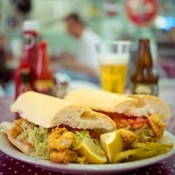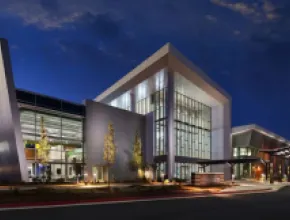As the “City that Care Forgot” continues to recover its pre-Katrina identity, the magic that was once New Orleans is far more than just a memory. While the media focuses on its slow state of recovery, the city’s decadent dining, soulful jazz, voodoo subculture, and eccentric art scene have already filtered back into the streets of the French Quarter, Warehouse/Arts District, Magazine Street, and other tourist havens.
“We are really a tale of two cities,” says Kelly Schulz, vice president of communications and public relations at the New Orleans CVB. “The historic New Orleans for visitors and convention delegates—the French Quarter and the convention center area—are alive and well. But the outlying neighborhoods that saw a lot of devastation, those are not back to normal, not even close.”
While insurance nightmares and development standstills plague hard-hit areas, recovery for the city’s meetings industry is moving forward at a faster clip. Reports place the levels of meetings business for 2007 at 70 percent of pre-Katrina levels.
“These are meetings that have been on the books a while,” Schulz says. “We have a lot of groups that have stuck with us.”
In March, the American College of Cardiology held the largest meeting to date since Hurricane Katrina, with 26,250 attendees pouring into New Orleans for the event. MPI also held a successful meeting in the Crescent City last January, hosting its annual Professional Education Conference–North America, with some 2,600 attendees.
“We’ve had a couple of cancellations,” Schulz says, citing the National Business Aviation Association, which rescheduled its meeting for 2008. The group was to use the Lakefront Airport for its private planes, which was the reason for the pullout. “The group is a longtime client, but they were concerned about the Lakefront Airport since that area is still problematic. They want to come back to us.”
The CVB is continuing its Forever New Orleans ad campaign to lure meeting planners, including short-term corporate groups.
“Forever New Orleans reflects a message of permanence of our culture in the city,” Schulz says.
Another focus for the CVB is bringing in planners for site inspections.
“The saying ‘seeing is believing’ holds true,” Schulz says. “Groups that come and do their research to see if our city is ready are not disappointed.”
Groups that have come back to the city have had very successful meetings, according to Schulz.
“We hear consistently that service levels in the city have exceeded expectations in terms of hospitality in the community,” she says. “From taxi drivers to bellmen, they say, ‘Thank you for being here.’”
Other positive comments have concerned the cleanliness of the French Quarter. New Orleans Mayor Ray Nagin recently contracted a new company to clean the streets.
“They are cleaner than they have ever been in my lifetime,” Schulz, a New Orleans native, says.
Meanwhile, groups are enjoying improved facilities, since properties have invested in major upgrades before reopening. Overall, 208 metropolitan-area hotels are back on-line, with 31,000 of 38,000 guest rooms available.
Except for The Fairmont New Orleans, which has not set a reopening date, and the Hyatt Regency New Orleans, slated to reopen in September 2008, all major hotels in New Orleans are back in business, including meetings favorites such as the Hotel Monteleone, with more than 20,000 square feet of meeting space; the Sheraton New Orleans, with more than 100,000 square feet of function space; the Hilton New Orleans Riverside, with 134,000 square feet of meeting space; and the New Orleans Marriott, with 80,000 square feet of function space.
The newly constructed Harrah’s Hotel opened in September 2006 with over 7,000 square feet of meeting space, and the Chateau Sonesta Hotel reopened last December after extensive renovations.
The Ritz-Carlton, New Orleans reopened last December following a more than $100 million post-Katrina restoration, and the Spa at The Ritz-Carlton, New Orleans reopened in April and features 22 treatment rooms, a new fitness center and an accompanying retail store. The spa was expanded to 25,000 square feet, making it the largest in the city.
Other hotels that reopened earlier this year include Iberville Suites, adding 230 rooms back to the city’s hotel inventory, and the 250-room Hilton New Orleans/St. Charles Avenue, featuring more than 15,000 square feet of function space.
Additionally, the mixed-use Trump Tower condominium development is slated for completion in 2009 and will house condo-hotels. The 67-story, 750-foot-high structure will be the tallest building in Louisiana.
Also on the books is the redevelopment of the World Trade Center into 250 residences and a 130-room Renaissance ClubSport Hotel. The $160 million project will also include the development of an international cultural museum and the conversion of Spanish Plaza into a public entertainment area.
Meanwhile, the Ernest N. Morial Convention Center, which took the wraps off a $60 million-plus renovation in spring 2006, is hosting more than 71 major conventions, trade shows and events this year, bringing nearly 350,000 out-of-state visitors to the city. Since Hurricane Katrina, 64 new events have confirmed, representing 404,915 attendees, and 131 tentative future events are in the works.
Later this year, the historic St. Charles Avenue streetcar is slated to make its full return to service, while next year, the Louisiana Superdome will host the Allstate Sugar Bowl, and the New Orleans Arena will be the site of the 57th NBA All-Star Game.
Leisure tourism numbers are also inching back. This year’s Mardi Gras, New Orleans Jazz & Heritage Festival, and French Quarter Festival each posted higher attendance than last year. The attendance for the Jazz Fest topped 375,000, the highest since 2003. During the last weekend of Mardi Gras, hotels reported a 95 percent occupancy rate, while the crowd throughout the festival was estimated at 800,000, still down from the pre-Katrina 1 million mark.
One issue continues to be the reduced air service to New Orleans. As of June, Louis Armstrong International Airport was at 75 percent of the number of pre-Katrina daily departures and 88 percent of the number of pre-Katrina destinations that it served. ExpressJet is now flying out of the airport, with 10 daily nonstop flights, including service to Austin and San Antonio, Texas; and Jacksonville, Fla. Schulz stresses that the CVB is working with the airlines and airport officials with regard to convention scheduling to ensure adequate flights to meet demand.
Demand also remains strong for voluntourism, with a number of groups lending a hand during their conventions with community projects spearheaded by organizations like Habitat for Humanity, Hands On New Orleans and the Beacon of Hope Resource Center. To help preserve the music of New Orleans, Habitat for Humanity, with the help of Harry Connick Jr., is building houses for displaced musicians in what is being called Musicians’ Village, located in the devastated area of the Lower 9th Ward. During their meeting in January, some members of MPI spent part of a day working on the project.
During its recent citywide conference of 24,600 attendees, Healthcare Information Management Systems Society (HIMSS) also got in on the act. The organization adopted a health care clinic, contributing equipment and consulting services.
“That was one of our forms of voluntourism,” says Karen Malone, vice president of meeting services for HIMSS, adding that the meeting was a success and the organization is looking to return in 2013.
Groups and visitors can check out www.volunteerlouisiana.gov for more information on projects that are seeking volunteers.
When groups are ready to let the good times roll, New Orleans is ready to entertain delegates; dozens of music clubs and restaurants are back in business (see Checking Out, page 54). Planners can also book dinner and jazz cruises with the New Orleans Steamboat Company on the Steamboat Natchez, combining New Orleans’ riverside setting with its rich musical heritage.
Additionally, several of the city’s arts and cultural institutions are available as off-site venues, including the New Orleans Museum of Art, which is open for private functions, as is the Ogden Museum of Southern Art.
Northshore/Jefferson Parish
Marketing itself as the New Orleans Gateway, Jefferson Parish sits just 25 minutes from the Big Easy and close to plantation country. Visits to plantation homes, as well as swamp tours and birding in Jean Lafitte National Historical Park and Preserve are among the many highlights for groups.
“We’re still in metro New Orleans, but you would never know it. The area looks like a country within a city,” says Violet Peters, president and CEO of the Jefferson CVB.
The parish, which includes Metairie, Westwego, Grand Isle State Park, and Kenner, is well equipped with rooms and amenities, according to Peters.
Available venues include the Pontchartrain Center, with close to 70,000 square feet of meeting space, as well as the John A. Alario Sr. Event Center. The Best Western Landmark in Metairie features the largest ballroom in the area.
Numerous off-site attractions such as the Treasure Chest Casino, the Louisiana Toy Train Museum, the Gretna Historical Society complex, and the Mardi Gras Museum in Kenner’s historic district of Rivertown are all open to groups.
Metairie’s Doubletree New Orleans Lakeside reopened in April as the New Orleans Marriott Metairie at Lakeway, with 250 rooms and 6,500 square feet of meeting space.
The Metairie Hotel, formerly a Wyndham property, was reflagged the Sheraton Metairie last August. The hotel offers 181 guest rooms and four meeting rooms.
St. Tammany Parish
To the north of the Big Easy, St. Tammany Parish rates as one of the top five fastest-growing areas in the country.
“A century ago people came here to get away from the city, enjoying the green spaces and small towns. Now more houses are being built, there is more traffic, but people also have more to do,” says Renee Kientz, communications director for the St. Tammany Parish Tourist and Convention Commission.
Outdoor escapes such as kayaking on Lake Pontchartrain, boating in the bayous and visiting the African-themed Global Wildlife Center are still main attractions, as is the Insta-Gator Ranch, an alligator farm that lets guests hold baby alligators as they hatch. Covington is a center for visual and musical arts, Slidell is popular for antique shopping, and the whole region is a burgeoning fine-dining haven.
For large groups, Slidell’s Northshore Harbor Center features 50,000 square feet of function space, and the Castine Center in Mandeville offers 28,000 square feet of flexible exhibit space. The Holiday Inn Covington has 8,500 square feet of flexible meeting space, and the Courtyard New Orleans Covington/Mandeville features four meeting rooms with a total of 3,200 square feet of meeting space.
Last November, Homewood Suites Covington opened with 86 guest rooms, a boardroom and two meeting rooms, and last September, La Quinta Inn and Suites Covington debuted with 65 guest rooms and 1,200 square feet of meeting space.
For More Info
Jefferson CVB 504.731.7083
www.neworleansgateway.com
New Orleans CVB 504.566.5011
www.neworleanscvb.com
St. Tammany Parish Tourist and Convention Commission 985.892.0520
www.neworleansnorthshore.com







